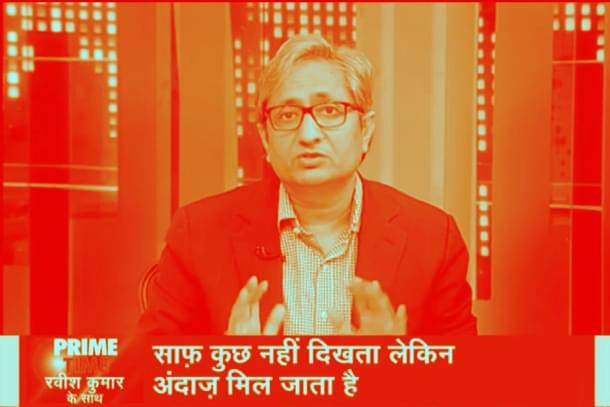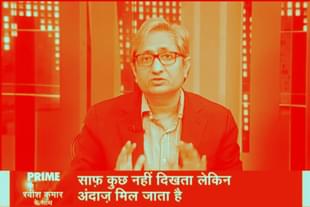Ideas
The Unbearable Sanctimony Of Being Ravish Kumar
Nishtha Anushree and Arush Tandon
Dec 04, 2022, 05:20 PM | Updated 05:20 PM IST
Save & read from anywhere!
Bookmark stories for easy access on any device or the Swarajya app.


On 5 November 2016, Ravish Kumar’s show featured two mime artists. Their faces painted in black and white to exaggerate their features, one of the artists seemingly played the part of a leader and the other of a ‘troll’. For a good 15 minutes, Ravish Kumar enquired from the two if he could ask them questions, and they replied in gibberish with some theatricality thrown in.
Was this Ravish Kumar’s response after he was punished by the government because one of his questions upset the party in power or its leader?
Not really.
The Ministry of Information and Broadcasting had contended earlier that day that the channel Kumar worked for, NDTV India, had given out ‘strategically sensitive’ information in its coverage of the Pathankot terror attack (2 January 2016). As a result, the Ministry invoked its powers under the Cable TV Networks (Regulation) Act and ordered the channel to go off-air for one day on 9 November 2016. (Later, even this order was revoked on 8 November).
If kitsch is defined as an ‘aesthetic ideal in which sh*t is denied and everyone acts as though it did not exist’, then the 5 November 2016 show of Ravish Kumar would fit that definition of kitsch.
But it wasn’t so always.
Ravish Kumar started off as an anchor who was seen bringing the stories of Hindi-speaking people to the TV screens, with a sensibility they could relate to, and in a style that wasn't jarring.
Many of Ravish Kumar's programmes in the early years appear to come from the school of thought that Hindi content didn't necessarily mean dumbing down issues for a 'rustic audience'. You could respect the viewer and do Hindi shows where you discussed literature or the tax policy of the government too.
The result: the audience returned the respect in kind.
It wasn't that Kumar of those years had a different worldview, or didn't have his biases. He did. But there seemed an inherent respect for the intelligence of the viewer.
It is unlikely that back then Kumar would have categorised any negative feedback or constructive criticism as ‘trolling’.
He would have probably conceded that those not agreeing with his views too had a moral legitimacy.
Today, however, we have numerous instances which strongly suggest that Kumar was ever-willing to make an exception for himself and ‘his side’ when it came to questions of media ethics and even when it came to plain facts.
In other words, hypocrisy.
And with this hypocrisy came a self-accorded aura of moral superiority and the romanticism of rebellion. The camera became a pulpit from where this lone philosopher-writer-anchor rebelled against the ‘might of the bad guys who were now in government’.
Take this as a case in point. Ravish Kumar resigned from NDTV this Thursday after the Adani Group's takeover of the media company. He tweeted that he will now be seen on his YouTube channel.
Kumar posted a video about his resignation on this channel where he spoke about the "bhasma yuga (the era of destruction)" of Indian journalism.
In the video, Kumar calls all other media institutions "Godi media" and asks his followers and the people to become an institution themselves and support independent journalism.
The first question is the obvious one: how is Gautam Adani having stakes in NDTV different from Mukesh Ambani having stakes in it?
The second question is obvious too: almost all news channels in India are owned directly or indirectly by big business groups and it has been so for a few decades. If this is the bhasma yuga of Indian media, then it is not starting now. It’s been on for a few years. Kumar thrived in this bhasma yuga himself. For him to now suddenly turn around and disown the parts that he doesn’t like is, to put it mildly, a bit rich.
While talking about ‘the people’, Kumar cited the example of the anti-CAA Shaheen Bagh protests and ‘farmers' movement’ and how he sees the ‘light of the sun in their resoluteness’.
It is important to note that out of all the events that he covered as an NDTV journalist, Kumar should specially mention these two and that too in glowing terms. By doing that, he subliminally posits them as the morally correct and popularly-validated.
In reality, the anti-CAA protests were about denying bare minimum assurance of citizenship to the severely persecuted minorities of India’s neighbourhood and ‘farmers’ protests’ were about resisting the three ‘farm laws’ which were essentially agro-economic common sense translated into policy.
Note also that we are yet to mention that both these ‘protests’ were directly and indirectly supported by forces which are potent national security threats.
It is not that Kumar does not know this. Everybody does. But the fact that he still chose to single them out for praise suggests that the respect for the viewers’ intelligence is now long gone and hypocrisy has become a habit rather than the occasional but all-too-human failing that it is in most of us.
Hypocrisy, in fact, is what stands out from an analysis of the recent work of Ravish Kumar.
One Twitter user has documented some of the most glaring of these examples in a thread:
When Kumar discussed the Aftab-Shraddha case, he besieged the viewer to not view the crime through a ‘communal angle’; when discussing the Hathras case he makes it a point to mention that the perpetrators all belonged to the ‘upper castes’.
Normally, you would think Kumar would not put out something on his programme without verifying it first. However, when the north-east Delhi riots broke out in 2020, Kumar showed the images of arsonist-shooter Shahrukh in his programme and gently let it slip in that the shooter was ‘in fact being identified as Anurag Mishra on social media’.
While speaking on the Kathua rape case, Kumar made it a point to name both the victim and the perpetrators. However, when it came to the Hyderabad case of 2019, Kumar cited the ‘Supreme Court’s guidelines on reporting rape cases’ and said that the same prevented him from sharing the name of the victim on his programme.
In the Delhi riots of 2020, one of the victims was a person named Shahid. The Delhi police had said in its report that Shahid was accidentally killed in firing by his fellow Muslim rioters. However, in his programme on the Delhi riots, Kumar had seemed to imply that Shahid was shot and killed by Hindu mobs.
Other instances of Kumar sharing unverified and outrageous claims include reports related to paddy procurement data from Punjab, to UP PET exam, to construction of a wall in Ahmedabad before Trump's visit and to dodgy claims about Covid estimates in India based on a dicey report. Even this list is non-exhaustive.
Ironically enough, the causes Kumar fervently and frequently espouses—anti-casteism, provision of amenities to the poor, women emancipation—are pursued on the ground with considerable success by the very forces he pits himself against: the RSS and the Modi government.
Yet, in his video of 1 December, Kumar almost scoffs at the idea of PM Modi sharing his journey from a tea-seller to a prime minister with the public. According to Kumar, he too had similarly humble beginnings but he would not invoke them publicly or try to gain sympathy from it like PM Modi.
Of course it is political messaging when BJP or Modi highlight his humble background. At the same time, it is equally a story of optimism and aspiration that much of India seems to identify with. And while this India is willing to be corrected where it goes wrong, it doesn’t have time for sermons, even if they are in chaste Hindi, from perennially grumpy men who appear sarcastically sullen at their best and angry at their worst.
With its twists and turns and punctuations, the India story will go on, and the Ravish Kumars of the world would grumble their way to irrelevance.




